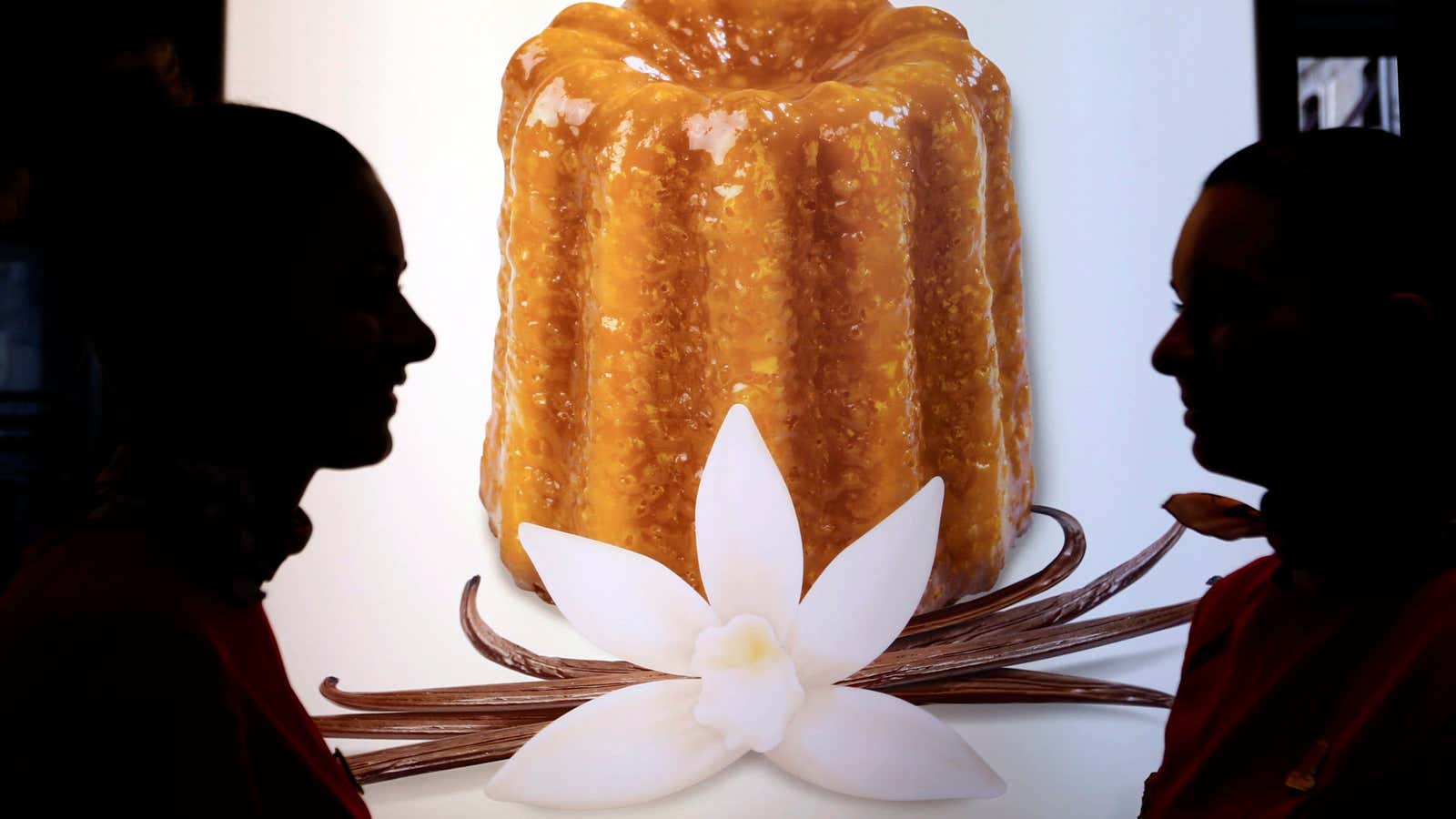We’re in the midst of a vanilla bubble. Cyclones in Madagascar, which produces about 75% of the world’s supply, have driven the price to record highs. And as prices continue to rise it’s worth thinking about swapping your vanilla extract for imitation vanilla flavor for some dishes. Yes, seriously, and not just because imitation vanilla actually works better in many cases.
Cooking sites love to recommend that serious bakers use only real vanilla extract, and if you’re really serious, actual vanilla beans or vanilla bean paste for all baking needs. As critics see it, the artificial stuff is less flavorful, or worse made from chemicals.
First, let’s address the idea that chemicals are somehow bad. Artificial vanilla flavor is made from vanillin, a chemical synthesized in a lab. The same chemical is also synthesized in nature, in the pods of the vanilla orchid. They are identical. In her book Eight Flavors, food historian Sarah Lohman travels to Mexico to see vanilla being cultivated. She writes:
It’s important to remember that vanillin, whether it’s sourced from a vanilla bean or synthesized in a lab, are the same thing. They are chemically indistinguishable. Vanillin is a very simple compound, C8H8O3 (a chemical bond of carbon, hydrogen, and oxygen.
Vanillin detractors love to point out that it is made from things like coal tar, wood pulp, even synbio yeast—a proposition that has some up in arms to which Lohman responds, “atoms don’t remember their history—the synthesized vanillin has no relation to its source.” Natural vanilla extract actually has more chemicals than vanillin. In the food science industry the standard test to distinguish between the two hinges upon 4-hydroxybenzaldehyde, which is absent from artificial vanilla flavorings.
But what about the flavor? Hands down, the flavor in a vanilla bean—or vanilla bean paste or extract—is more nuanced, complex, and interesting than straight vanillin. That’s because of chemicals—there are way more of them in a vanilla bean. Vanillin only accounts for about a third of the aroma and flavor of real vanilla, the balance is a combination of other compounds that vary depending on where the vanilla was produced and which variety it is.
The problem, though, is that all those notes of rum, cinnamon, and sandalwood that give vanilla its beautiful complexity are volatile, and they degrade quickly in high temperatures, like the ones in your oven. Lohman recounts an experiment in which she gave a lecture about vanilla and then served the crowd two different batches of snickerdoodles, the only difference between them being that one was made with natural vanilla the other was made with artificial vanilla. The artificially flavored cookies won the taste test two-to-one.
Epicurious recreated Lohman’s bake-off with the same results. They preferred the imitation vanilla in cookies. Even Cook’s Illustrated had to admit that when it comes to baking, cakes, cookies, and the like, there is little detectable difference in the final product. And therein lies the answer: For more delicate items cooked at a lower heat—or no heat at all—think pudding, creme bruleé, and ice cream, real vanilla is more complexly delicious. For anything that goes into a 300-degree oven, stick with vanillin.
Considering the people who grow vanilla is also an issue, as with similar global agri-commodities like coffee and chocolate. Poverty rates are high in Madagascar, which has also been hit hard by political turmoil, rising food costs, and climate change. The vanilla market is largely unregulated, and it’s widely assumed that commodity speculators, in addition to cyclone damage to crops, is part of the reason that prices have ballooned.
One strategy is to use imitation vanilla in your cookies and cakes, and then save your spice dollars to flavor ice cream with vanilla produced by a company like Madécasse. The firm focuses on sourcing vanilla and cacao—another major crop on the island—directly from farmers, so that they get cash that would normally go to a middle man. Co-founder Tim McCollum served in the Peace Corps and returned to the US with the idea of starting a Madagascar-based business; he has zero romantic notions about vanilla being a local delicacy or anything other than an economic engine.
“People in Madagascar don’t have ovens,” he told NPR. “They’re preoccupied with feeding their families. Baking is a luxury; it’s not a necessity of life.”
